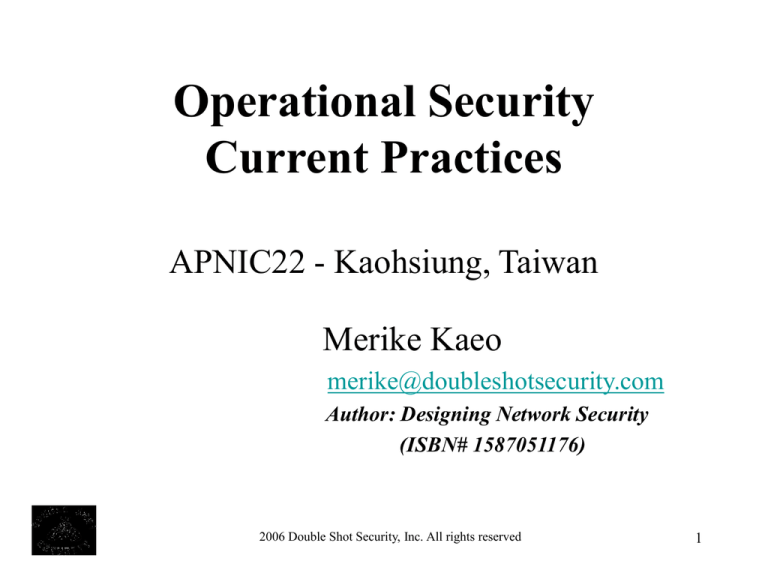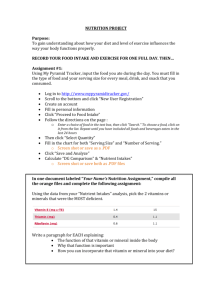
Operational Security
Current Practices
APNIC22 - Kaohsiung, Taiwan
Merike Kaeo
merike@doubleshotsecurity.com
Author: Designing Network Security
(ISBN# 1587051176)
2006 Double Shot Security, Inc. All rights reserved
1
Infrastructure Security
Customer
Peer
Customer
NetFlow,
SNMP
Syslog, TFTP,
AAA, DNS,
SMTP
2006 Double Shot Security, Inc. All rights reserved
NOC
2
How Do Large ISPs Protect
Their Infrastructures ?
• Understand the Problem
• Establish an Effective Security Policy
–
–
–
–
–
physical security
logical security
control/management plane
routing plane
data plane
• Have Procedures In Place For Incident Response
– procedures for assessing software vulnerability risk
– auditing configuration modifications
2006 Double Shot Security, Inc. All rights reserved
3
Attack Sources
• Passive vs Active
– Writing and/or reading data on the network
• On-Path vs Off-Path
– How easy is it to subvert network topology?
• Insider or Outsider
– What is definition of perimeter?
• Deliberate Attack vs Unintentional Event
– Configuration errors and software bugs are as harmful as a
deliberate malicious network attack
2006 Double Shot Security, Inc. All rights reserved
4
Operational Security Impact
• Unauthorized Disclosure
– circumstance or event whereby entity gains access to data for which it is
not authorized
• Deception
– circumstance or event that may result in an authorized entity receiving
false data and believing it to be true
• Disruption
– circumstance or event that interrupts or prevents the correct operation of
system services and functions
• Usurpation
– circumstance or event that results in control of system services or
functions by an unauthorized entity
2006 Double Shot Security, Inc. All rights reserved
5
Security Services
•
•
•
•
•
•
•
•
User Authentication
User Authorization
Data Origin Authentication
Access Control
Data Integrity
Data Confidentiality
Auditing / Logging
DoS Mitigation
2006 Double Shot Security, Inc. All rights reserved
6
Functional Considerations
• Device Physical Access
• Device In-Band
Management
• Device OOB
Management
• Data Path
• Routing Control Plane
• Software Upgrade /
Configuration Integrity
• Logging
• Filtering
• DoS Tracking /Tracing
– Sink Hole Routing
– Black-Hole Triggered
Routing
– Unicast Reverse Path
Forwarding (uRPF)
– Rate Limiting
2006 Double Shot Security, Inc. All rights reserved
7
Device Physical Access
• Equipment kept in highly restrictive
environments
• Console access
– password protected
– access via OOB management
• Individual users authenticated
• Social engineering training and awareness
2006 Double Shot Security, Inc. All rights reserved
8
Device In-Band Management
• SSH primarily used; Telnet only
from jumphosts
• All access authenticated
– Varying password mechanisms
– AAA usually used
– Single local database entry for
backup
• Each individual has specific
authorization
• Strict access control via
filtering
• Access is audited with triggered
pager/email notifications
• SNMP is read-only
– community strings updated
every 30-90 days
2006 Double Shot Security, Inc. All rights reserved
9
Device OOB Management
•
•
SSH primarily used; Telnet only from
jumphosts
All access authenticated
– Varying password mechanisms
– AAA usually used (server typically
different for in-band vs OOB)
– Single local database entry for
backup
•
•
•
•
Each individual has specific
authorization
Strict access control via filtering
Access is audited with triggered
pager/email notifications
SNMP is read-only
– community strings updated every 3090 days
2006 Double Shot Security, Inc. All rights reserved
10
Data Path
• Filtering and rate limiting are
primary mitigation techniques
• BCP-38 guidelines for ingress
filtering
• Null-route and black-hole any
detected malicious traffic
• Netflow is primary method used
for tracking traffic flows
• Unicast Reverse Path
Forwarding is not consistently
implemented
• Logging of Exceptions
2006 Double Shot Security, Inc. All rights reserved
11
Routing Control Plane
•
MD-5 authentication
– Some only deploy this at customer’s
request
•
•
•
Route filters limit what routes are
believed from a valid peer
Packet filters limit which systems can
appear as a valid peer
Limiting propagation of invalid routing
information
– Prefix filters
– AS-PATH filters (trend is leaning
towards this)
– Route dampening (latest consensus is
that it causes more harm than good)
•
Not yet possible to validate whether
legitimate peer has authority to send
routing update
2006 Double Shot Security, Inc. All rights reserved
12
Software Upgrade / Integrity
•
•
•
•
•
•
•
Files stored on specific systems with
limited access
All access to these systems are
authenticated and audited
SCP is used where possible and FTP is
NEVER used
Configuration files are polled and
compared on an hourly basis
Filters limit uploading / downloading
of files to specific systems
Many system binaries use MD-5
checks for integrity
Configuration files are stored with
obfuscated passwords
2006 Double Shot Security, Inc. All rights reserved
13
Filtering Considerations
Routing Control Plane
Data Forwarding Plane
Management Plane
Telnet, SSH
DNS Server
Mail Server
AAA, Syslog, SNMP Server(s)
2006 Double Shot Security, Inc. All rights reserved
14
DoS Tracking / Mitigation
( Sink Hole )
– Router or workstation built to
divert traffic and assist in
analyzing attacks and determine
the source.
– Used to redirect attacks away
from the customer – working the
attack on a router built to
withstand the attack.
– Used to monitor attack noise,
scans, data from misconfiguration and other activity
(via the advertisement of default
or unused IP space)
Backscatter
Scanners
Internet
Peer
Worms
Diverts
unwanted
packets.
Border
Large CIDR Block
Out
Aggregation
Customer’s
Allocated Block
CPE
2006 Double Shot Security, Inc. All rights reserved
15
DoS Tracking / Mitigation
( Black-Hole Triggered Routing )
•
Several Techniques:
– Destination-based BGP Blackhole
Routing
– Source-based BGP Blackhole
Routing (coupling uRPF)
– Customer-triggered
•
Exploits router’s forwarding logic
which typically results in desired
packets being dropped with
minimal or no performance impact
Packets
Arrive
FIB
---------------------------------------
Ingress
Packet
Filter
Egress
Interface
--------------------
Null0/ Discard
• Forward packet to
the Bit Bucket
• Saves on CPU and
ACL processing
2006 Double Shot Security, Inc. All rights reserved
16
DoS Tracking / Mitigation
( uRPF )
Routing Table:
210.210.0.0
172.19.0.0
via 172.19.66.7
is directly connected, Fddi 2/0/0
CEF Table:
210.210.0.0
172.19.66.7
172.19.0.0
attached
Adjacency Table:
Fddi 2/0/0 172.19.66.7
Data
IP Header
In
50000603E…AAAA03000800
Unicast
RPF
RPF Checks to See if
the Source Address is
in the FIB
If OK, RPF
Passed the
Packet to be
Forwarded
Data
IP Header
Out
Drop
Dest Addr: x.x.x.x
Src Addr: 210.210.1.1
Fddi 2/0/0
Fddi 2/0/0
Source Address must
match the FIB information
in the CEF Table. If in the
FIB – then OK. If equal to
Null 0, then drop.
2006 Double Shot Security, Inc. All rights reserved
17
IPv4 vs IPv6
• Same considerations exist for IPv6
networks although the same tools are not
yet there for IPv6 transports
• IPv6 / IPv4 tunnels used to hide malicious
traffic from filtering rules is a concern
• Flow collection tools are not yet capable of
detecting much malicious traffic
2006 Double Shot Security, Inc. All rights reserved
18
Operational Practices Summary
• Risk mitigation techniques similar yet
different
– Similar conceptual safeguards
– Differences based on performance issues and
operational complexity
• Infrastructure products need standardized
capabilities for more effective security
deployments
2006 Double Shot Security, Inc. All rights reserved
19
THANK YOU!
( draft-ietf-opsec-current-practices-06.txt )
2006 Double Shot Security, Inc. All rights reserved
20






